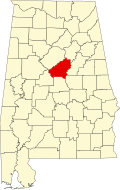Brantleyville, Alabama | |
|---|---|
 Location of Brantleyville in Shelby County, Alabama. | |
| Coordinates: 33°13′09″N86°52′34″W / 33.21917°N 86.87611°W | |
| Country | United States |
| State | Alabama |
| County | Shelby |
| Area | |
• Total | 2.20 sq mi (5.71 km2) |
| • Land | 2.20 sq mi (5.69 km2) |
| • Water | 0.012 sq mi (0.03 km2) |
| Elevation | 548 ft (167 m) |
| Population (2020) | |
• Total | 931 |
| • Density | 423.9/sq mi (163.68/km2) |
| Time zone | UTC-6 (Central (CST)) |
| • Summer (DST) | UTC-5 (CDT) |
| Area codes | 205, 659 |
| GNIS feature ID | 2582663 [2] |
Brantleyville is a census-designated place and Unincorporated community in western Shelby County, Alabama, United States. Its population was 884 as of the 2010 census. [3]
